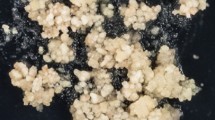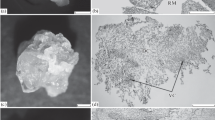Abstract
The cytoplasmic effects on embryo culture responses were studied by using calli from mature embryos of four genotypes of winter wheat (Triticum aestivum L.). Significant reciprocal differences were found for tissue culture response of callus, indicating that a cytoplasmic effect may be involved. In general, cytoplasm positively affected callus induction, regeneration capacity of callus, culture efficiency and numbers of regenerated plants. The nature of the effect of the cytoplasm is shown to depend on the genotype. The potential for improving the responses of tissue culture by cytoplasmic changes was observed.
Similar content being viewed by others
References
Ahmed KZ, Bartok T & Sagi F (1992) A modified method for rapid callus induction by utilization of endosperm metabolities in mature and immature seeds of bread wheat (Triticum aestivum L.) and durum wheat (Triticum durum L.). Cereal Res. Commun. 20: 81–86
Bebeli PJ (1995) Cytoplasmic effects on tissue culture response in wheat. J. Genet. Breed. 49: 201–208
Bruins MBM & Snijders CHA (1995) Inheritance of anther culture derived green plantlet regeneration in wheat (Triticum aestivum L). Plant Cell Tiss. Org. Cult. 43: 13–19
Charmet G & Bernard S (1984) Diallel analysis of androgenic plant production in hexaploid triticale (χ Triticosecale Wittmack). Theor. Appl. Genet. 69: 55–61
Felsenburg T, Feldman M & Galun E (1987) Aneuploid and alloplasmic lines as tools for the study of nuclear and cytoplasmic control of culture ability and regeneration of scutellar calli from common wheat. Theor. Appl. Genet. 74: 802–810
Kaleikau EK, Sears RG & Gill BS (1989) Monosomic analysis of tissue culture response in wheat (Triticum aestivum L.). Theor. Appl. Genet. 78: 625–632
Lörz H, Göbel E & Brown P (1988) Advances in tissue culture and progress towards genetic transformation of cereals. Plant Breed. 100: 1–25
Mathias RJ, Fukui K & Law CN (1986) Cytoplasmic effects on the tissue culture response of wheat (Triticum aestivum) callus. Theor. Appl. Genet. 72: 70–75
Özgen M, Türet M, Altìnok S & Sancak C (1998) Efficient callus induction and plant regeneration from mature embryo culture of winter wheat (Triticum aestivum L.) genotypes. Plant Cell Rep. 118: 331–335
Sagi L & Barnabas B (1989) Evidence of cytoplasmic control of in vitro microspore embryogenesis in the anther culture of wheat (Triticum aestivum L). Theor. Appl. Genet. 78: 867–872
Author information
Authors and Affiliations
Corresponding author
Rights and permissions
About this article
Cite this article
Özgen, M., Türet, M. & Avci, M. Cytoplasmic effects on the tissue culture response of callus from winter wheat mature embryos. Plant Cell, Tissue and Organ Culture 64, 81–84 (2001). https://doi.org/10.1023/A:1010609603915
Issue Date:
DOI: https://doi.org/10.1023/A:1010609603915




